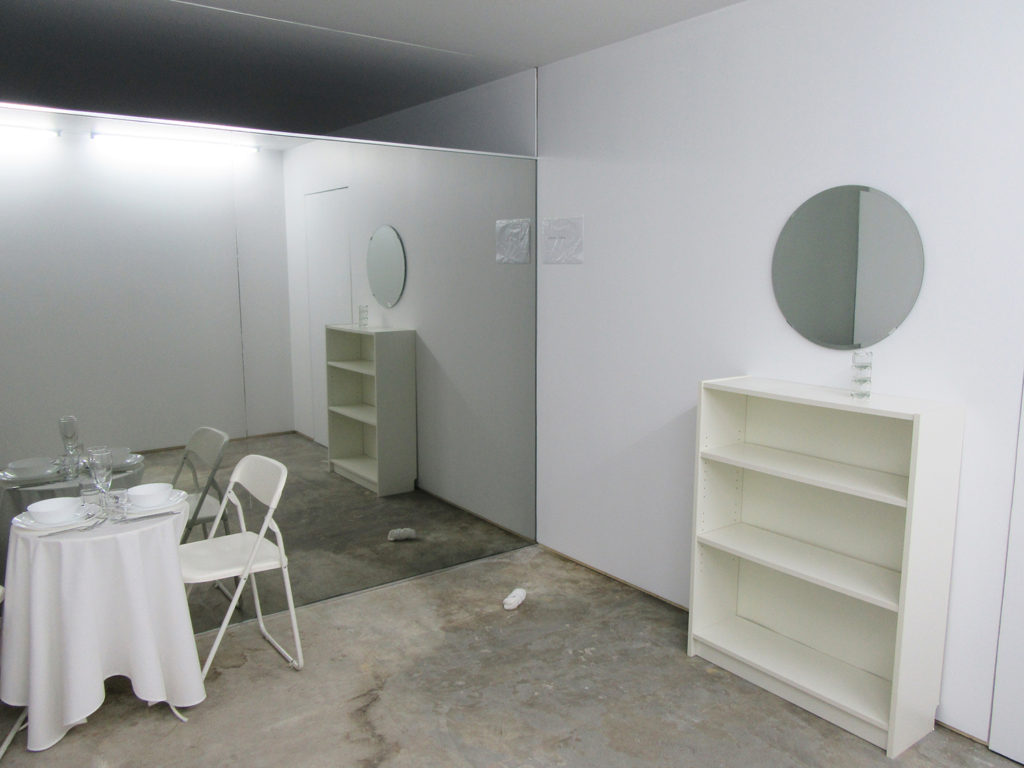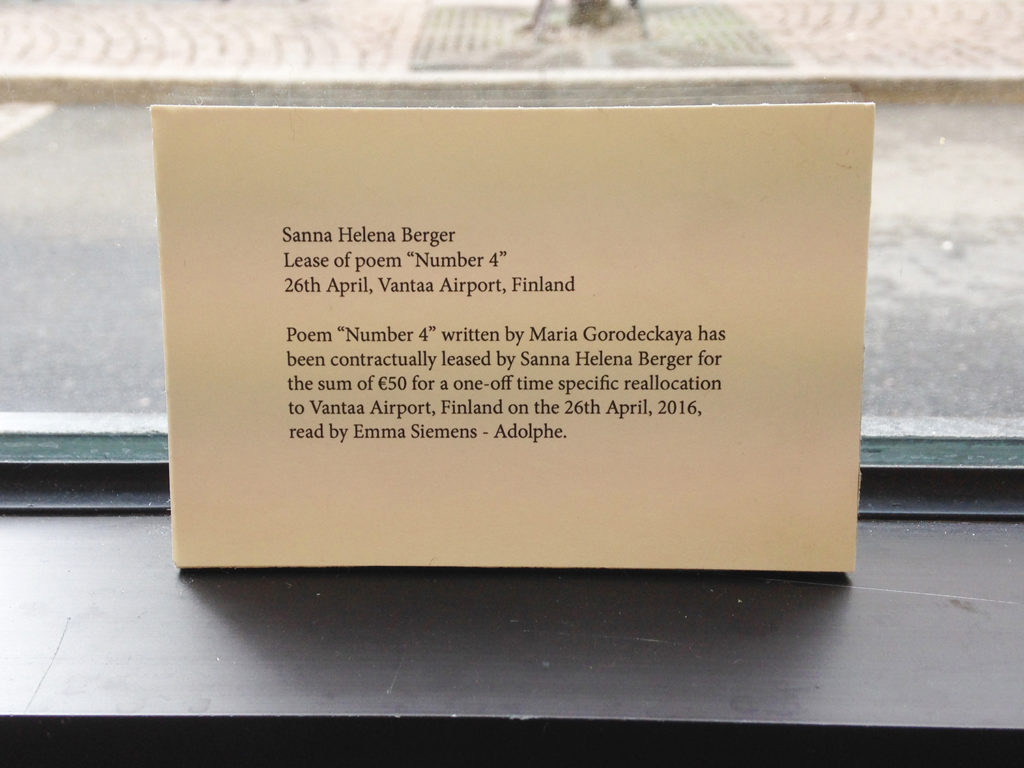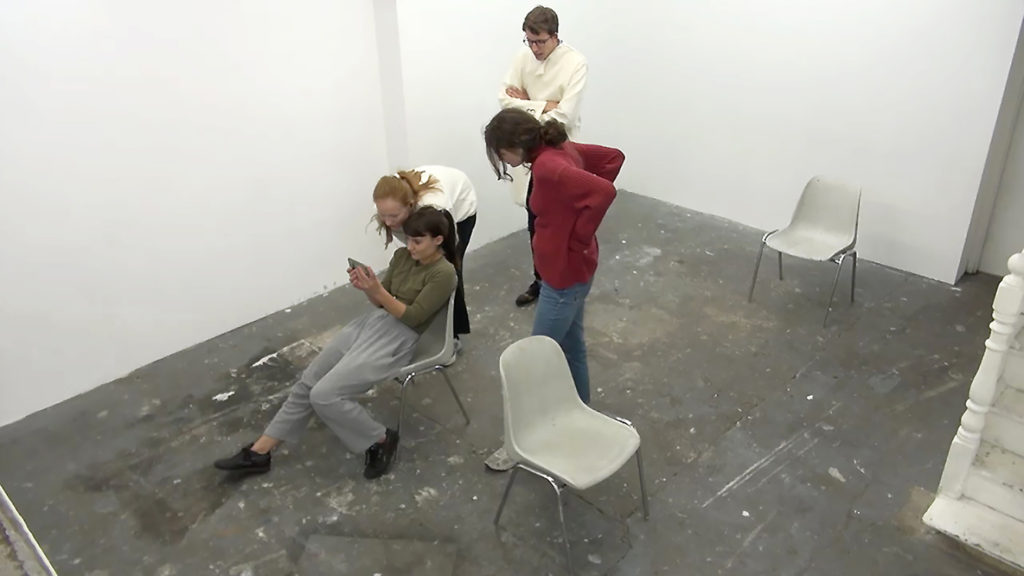Sanna Helena Berger’s work is difficult to define. You could call it ‘performance’ but that doesn’t quite do it justice. Hovering between institutional critique and a dissection of the intimate, the Swedish artist takes these two apparently antonymic subjects and makes them meet inside the white cube. For a solo at Oslo’s Diorama called The edge must be scalloped Berger built a room in the exhibition space guarded by invigilators. Upon entering, the public was presented with a minimal dining room with a mirror on one wall. On closer examination, it reveals itself as mirrored glass with a replica of the settings in which the viewer is standing on the other side, making them acutely aware of their context; of viewing themselves inside an installation.
“I was always really interested in behaviour”, Berger explains while walking through Liverpool Street, the heart of London’s financial district, where the artist has been scouting for film locations. “This is true especially since I started working in a gallery context —which is fairly new to me —not someone’s house or a project space, but in an actual gallery. This is such a clear arena for art; the standards are already set before you put anything in this room.”

Berger’s solo project, curated by Rosanna Puyol running at London’s Union Gallery from the May 14 to June 25, A sequence which corresponds, is approaching and, while she’s relaxed, one can sense her focus is firmly on what is still to be done. As we walk, we’re commenting on the neighbourhood; how different the area is to what we are used to walking around. Berger tells me she’s been enjoying watching businesspeople going by their daily lives all morning. Soon we’re away from the skyscrapers of the city, looking for a park, and before we know it we’re in Shoreditch —flamboyant symbol of London’s rampant gentrification —enjoying the sun in the backyard of a coffee shop.
Berger seems always in movement, traveling across Europe from residency to residency, like Residencia El Roquissar a private program in Majorca and Rupert in Vilnius among others. London is a recurrent stop between places. It’s as if Berger is always being drawn back. Despite the constant motion, she wears her status as an art vagabond well. The lack of stability doesn’t appear to affect her. It looks more like a natural state that echoes back to the variety of her interests. Berger is a prolific artist, she collaborates regularly, organizes workshops, writes texts; her route is strewn with manifestations of her research and its influence of the people she meets.
When looking at Berger’s work it makes sense. Her practice often deploys an administrative-like mechanism with very minimal physical production; it needs to be whole to function. There is construction during her shows, instructions are being given, habits turned upside down and performers execute tasks; you, the public, are entering a well-planned ballet. Working in parallel with her work, she unfolds her thought process in her writings, where she directly challenges the reader to escape the tyranny of extraordinary life.

Your work makes me think of Jean-Paul Sartre describing a waiter performing being a waiter in Existentialism and Humanism; a state where you’re not aware that you perform, yet you perform. What is your relationship to this idea of performativity of life?
Sanna Helena Berger: When I started working with performance I thought it was a very difficult to define. I had such a classic view of a performative element. It was more of a hindrance to me. Of course, you can have a performative quality without engaging in a performance. At the opposite my earlier work was very much a clearly defined ‘performance’, structured and choreographed. I think my work has developed away from that starting point. I tried to remove this very evident aspect and blend it as an element within an installation rather than ‘a performance’.
Before it was a set sequence, with a clear starting and stopping point, it became almost theatrical which is something I really wanted to step away from. The first work that I exhibited with live performance was by far the most clearly choreographed. Since then I definitely moved more into working with performance where you don’t have the clear definition of, ‘what is a found moment’, ‘who is an actor’, ‘what I placed in this situation’, ‘what is not naturally occurring in the space?’
I’m intrigued with this balance between knowing and not knowing because that makes you question what performance is, and I do that all the time. I don’t really know. My original idea of performance was, let’s say, very classic. But I find working with this element the most giving when it is unclear. That poses the question of ‘why’, ‘how’, ‘when’, ‘where’, and also ‘who’. That leads to more questions, something I really like; when you don’t have a clear discourse with your work, you have something that makes you question it.
You talked about theatre being an absolute ‘no-no’. But I am interested in how your work sometimes operates similarly. So what is the difference for you between theatre and the white cube?
SHB: The standards are already set before you put anything in this room. There are certain behaviours we expect, certain things we expect to see and hear. Especially when it comes to its most socially exploratory situation; the opening.
It can be quite limiting to be in a space where whatever you house is defined as art. I always question where the art is within my work, because I don’t have those clear boundaries. I don’t shy away from the most basic questions about art. Not all of my work is necessarily art to me. Maybe it is a bit the same with performance, I am not sure how I am defining this yet. But, of course, once you place it in this white room, it’s art. Maybe for me the art came before that. For example, with what I’m doing for my upcoming show at Union Gallery is moving its storage into their gallery space. It is confusing for me to work with a commercial gallery. So it was very important to tackle this question: ‘How do I go about it?’ What I did was take what they already own, artworks housed in their storage and re-allocate it in their gallery space. In the storage it’s essentially a passive artwork, it’s wrapped up and who knows how long it is going to be in there; waiting, in resting mode…

With doing that I am also freeing up new space, I’m diverting people into a space they would not see otherwise. It’s storage. This question of how to divert movement comes into play a lot when I see a gallery. For me I already did the ‘art’. It was an action. I did it a week ago, I moved it carefully and placed it back in the gallery, the new storage. That fascinates me, that action of moving, the decision-making, the process of it.
Situations often feel pre-scripted in your work. You write about the ‘pretence to be at ease’, and at the same time you’re calling your public to misbehave. But there is a structure clearly outlined. So isn’t it also a confirmation of these norms?
SHB: I love that you say that because actually, you posing this question back to me is somehow a validation that what I’m trying to do is working. This reflection that you have is something I’m looking to place within you, a chance to question the system.
I think you’re completely right, I definitely have an approach that you could call a script, a predetermined composition. Yet in that composition there is room for movement, for people to interpret that situation. It shouldn’t have this ‘aha! This is what she means!’ moment. I’m not looking for that, I’m looking for you to individuate yourself, pose questions to yourself and maybe to others. It could grow into a discussion -that would be wonderful, in fact. It shouldn’t be depending on some kind of basic understanding of Fine Art. I would love it if it could be a situation where people who are not usually situated in this kind of environment came in and start to question it, it would inevitably lead to a new way of seeing the work.
There was a guy who walked into my show in Norway. He came in with his fluorescent yellow work suit. Eventually I asked what he thought of the work. It was an installation with two rooms that you could enter only one by one; inside was a domestic scene, a table setting with two knives and two forks. He said he really liked it, he felt really comfortable, but he couldn’t understand why two knives and two forks. It seemed to have very little importance to the installation but, at the same time, of course it had a huge importance. It is a completely valid question. ‘Why would you have two knives and two forks?’ It is a question I didn’t pose myself when I laid out the table-setting. Yet, that is the first thing he thought about. I love that completely different point-of-view, which comes from a social background. It’s something I didn’t think of myself, and now I have this new aspect of the work; something that has nothing to do with ‘the art’, but more with the social-setting and what that meant to someone else. Even though he came from a very different context, he still had a thought, a question. He had something to refer back to me.

In your Domestic Manifesto text you talk about resisting the extraordinary and savour the pleasure of banality. I was wondering where that would place extreme feelings. In this spectrum, you’re expected to cry, to laugh, to feel rage. What if all these feelings were also being codified?
SHB: It’s interesting, I think my fascination with mundanity, – the ordinary, the everyday life – is because I have a lot of ups and downs, a lot of extreme highs, and extreme lows. I have very little of these in-between moments. Emotionally I have difficulties with these. The Manifesto is not only a manifesto to inspire others but also definitely an encouragement to myself. It’s almost autobiographical in the sense that it relates directly back to how, a lot of the time I forget to find quality in these bland moments. I travel a lot, I spend brief amounts of time in places, making it almost impossible to develop a routine. I find it very difficult to stop working. I don’t know if I’m stressed because I can’t quantify the stress anymore. I don’t know what the other state is. I do yoga to relax, but even those moments are more the illusion of having those qualities present in my life.
I think I have such an attentive view of these everyday mundane things, because it’s actually a rarer occurrence for me. I find myself going through those motions, like washing clothes and shopping for an entire week as something that is quite extraordinary. It is this moment that I have to stop and contemplate what it is I’m doing. When you say those extreme feelings, like rage, or love, hate, I quite often find those feelings in the moment most people find extremely bland. When I’m forced to be still, reflect, put my feet up, not work, then I get those feelings. They encourage those feelings because the other states have become so normal to me that I don’t think about them in this extreme sense anymore. They are my mundanity now. I find bland moments very beautiful in the simple sense that it is something that I don’t do all the time. It’s a bit like holidays.**
Sanna Helena Berger’s A sequence which corresponds is on at London’s Union Gallery, running from May 13 to June 25, 2016.
Header image: Sanna Helena Berger, The edge must be scalloped (2015). Courtesy the artist + Jupiter Woods, London.













